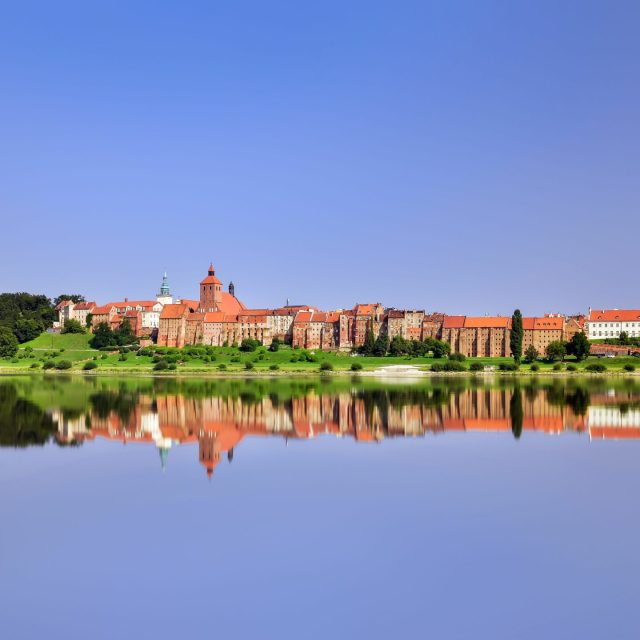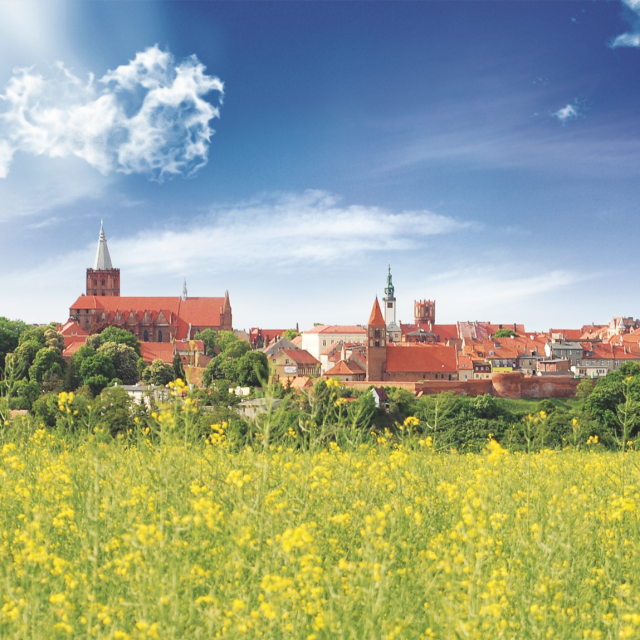Das Land ist geprägt von seiner Verschiedenheit. Im Süden Polens liegen die Karpaten mit dem Tatra-Gebirge, das Beskiden- und Bieszczady-Gebirge, sowie die Sudeten. Hier grenzt Polen an die Tschechische und Slowakische Republik. Die östlichen Nachbarn sind Litauen, Weißrussland, die Russische Föderation und die Ukraine, während westlich der Oder Deutschland beginnt. Landschaftlich besonders attraktiv ist die Masurische Seenplatte im Nordosten Polens, wo eine einzigartige Tier- und Pflanzenwelt beheimatet ist. Reizvoll ist auch die Ostseeküste mit ihren weitläufigen Sandstränden, Dünen und hohen Klippen. Nahe der Ostseeküste findet man auch die alten Ostseehäfen, denen man ihre große Vergangenheit noch immer ansieht, z. B. Szczecin, das den größten polnischen Ostseehafen besitzt, oder Gdańsk mit seiner bedeutenden Geschichte und der Marienkirche, die 20.000 Menschen Platz bietet. Bedeutende Orte sind auch Toruń und Malbork mit seiner Ritterordensburg aus dem 13. Jahrhundert.
Poland
Sławno

Sławno is one of the oldest cities in the north of Poland. Its settlement history dates back to the 12th century. In 1317 the town was founded according to Lübeck law. In its long history the town experienced numerous changes of sovereign: it belonged to various Pomeranian duchies and was temporarily annexed to the Kingdom of Poland and the Mark Brandenburg. The spiritual life in the town was dominated by the Order of the Knights of St. John, who already owned a religious house here before 1155 and had the right of patronage over the town churches.
Olsztyn

Olsztyn belonged to the dominion of the Warmian cathedral chapter in Frombork and was granted municipal rights in 1353 by the chapter. In the Middle Ages Olsztyn was one of the most important centres of power of the Prince Bishopric of Warmia within the State of the Teutonic Order, being the seat of one of the three administrative units subject to the cathedral chapter, which, together with the administrative units directly subordinate to the bishop, formed the Prince Bishopric. Today Olsztyn is the capital of the Warmia-Masuria Voivodeship. The glorious past of the city is well reflected in the Brick Gothic buildings of the Old Town – the Castle of the Warmian Cathedral Chapter, St. James’ Cathedral, the Old Town Hall, the High Gate and the remains of the fortified walls. The medieval road network is still visible today.
Stargard

Stargard ist eine Stadt mit zahlreichen Spuren pommerscher Geschichte und das in prächtiger Form, trotz Katastrophen, die die Stadt heimgesucht haben. Die emporsteigende, edle Gotik der Kirchen zeugt von der menschlichen Schaffenskraft. Insbesondere die monumentale und zugleich subtile Architektur der Marienkirche. Das in großen Abschnitten erhaltene System von imposanten Befestigungsanlagen gibt Zeugnis über Reichtum, aber auch Umsicht der Bürger dieser hanseatischen Stadt. Der Ihnafluss, grüne Parkanlagen rund um die Altstadt, das Rathaus und die Bürgerhäuser bestechen mit ihrer einzigartigen Schönheit und Atmosphäre. Die Zerstörungen des letzten Weltkrieges haben die damalige Stadt beinahe dem Erdboden gleich gemacht. Leider sind die meisten Bürgerhäuser innerhalb der Stadtmauern nicht erhalten geblieben. Glücklicherweise konnte das Wichtigste wieder aufgebaut werden, so dass das heutige Panorama der Stadt, das im Herzen der Stargarder einen festen Platz einnimmt, wieder an das vor vielen Jahren erinnert.
Grudziądz

The town of Grudziądz in former West Prussia is located on the right bank of the Vistula between Toruń and Gdańsk. In 1291 the town was granted municipal privileges by Kulm law and was surrounded by a town wall in the following years. In the course of the 14th century it developed into a centre for grain trade. Even today, the old town on the river still has 26 imposing Gothic granaries. Besides its Gothic monuments, the medieval town features three Baroque monasteries: the Benedictine Abbey with the Church of the Holy Spirit, the Jesuit College with the Church of St. Francis Xavier and the Reformed Monastery with the Church of the Holy Cross.
Płock

Płock is the former capital of Mazovia. The city can look back to a thousand years of history and is one of the oldest cities in Poland. As early as the 12th century, a first church was built on Tumskie Hill in the same site where today’s cathedral is towering majestically over the city. The remains of the Polish rulers Władysław I Herman and Bolesław III Wrymouthrest rest here in a marble sarcophagus. At the time of their reign, Płock was the capital of Poland. The city is beautifully set on a high embankment above the Vistula. The river itself offers excellent conditions for sailing and other forms of water sports while its embankment is ideal for walking, jogging and cycling.
Chełmno

Chełmno – Hanseatic City, sits picturesquely on the nine hills of th Chełmno High Plains – is the former capital of the historic Chełmno Land. First mentioned in 1065, the origins of Chełmno date back to an early medieval settlement with craft and trading character in Kałdus on St. Lawrence’s Hill (4 km south from the present city), and the village of Starogród (7 km south from Chełmno) – the seat of the first Teutonic Commandry called Chełmno Commandry. The Foundation Charter, the so-called “Chełmno Law” (based on the Magdeburg, Flemish and Hungarian laws) bestowed on Chełmno by the Teutonic Knights Order on 28 December 1233. Following this example more than 225 Polish towns (including Warsaw, Gdańsk, Toruń and Wadowice) and 1364 villages and many small settlements until the 18th century were founded up the 18th century. Chełmno pravides the visitor with a wide range of well-preserved buildings and interesting artifacts from virtually all historic periods since the Middle Ages. Highlights include the completely preserved grid-shaped structure of the ancient town centre with its 2,270 m long medieval wall as one of the most accomplished examples of a defensive architectural anywhere in Europe; furthermore, the Gothic-Renaissance City Hall – as […]
Myślibórz

Myślibórz is located in the south-western part of the West Pomeranian Voivodeship, at the heart of the Myślibórz Lake District. The city was founded in the 13th century under Magdeburg law and was the capital of the historic Neumark for several centuries. Many interesting sights have been preserved from that era to this day.
Gdańsk

The former Hanseatic City of Gdańsk used to be the most important Baltic Sea port in the historical region of Pomerilia. Its history goes back more than a thousand years. Around 1224, the merchant settlement was granted city rights by the Pomeranian Duke Swantopolk II. It quickly developed into an important trade location, making it the object of desire of numerous territorial lords over the centuries. During its eventful history, the city reached its greatest economic boom in Hanseatic times during the 14th and 15th centuries, a period of affluence evidenced by its impressive Brick Gothic buildings like St. Mary’s Church. During the Gothic period, numerous other brick churches and monasteries were built in Gdansk: the Parish Church of St. Catherine, the Dominican Church of St. Nicholas’, the Franciscan Church of Holy Trinity with its beautiful crown-like gables, the Church of St. John, which was most affected during the Second World War, and many others. They all have a spacious hall architecture. Inside, you will see beautiful forms of vaulting (reticulated, stellar and cellular), pointed-arched portals, decorative elements made of ashlar and noteworthy altars and choir stalls.






